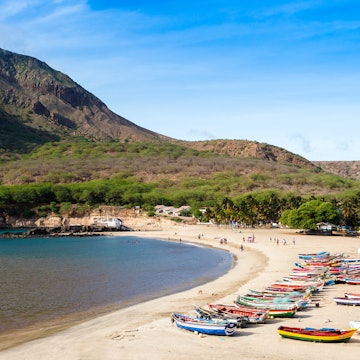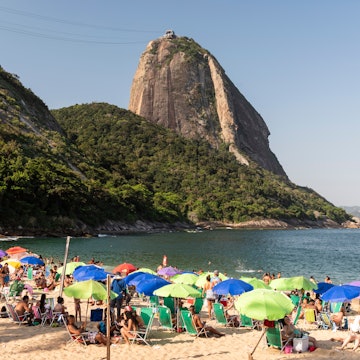

Here are the best transportation options for getting around in Brazil. Guaxinim/Shutterstock
Think of Brazil and huge swaths of tropical rainforest, swampy wetlands, rolling grasslands, rugged plateaus and green mountains come to mind.
You might assume that traveling around the world’s fifth-largest country would take a lifetime, but – while it can take a bit of planning – getting around this huge nation can be surprisingly easy.
These days, you can cross Brazil’s patchwork of ecosystems and unique topography in a variety of relatively swift ways, including traveling by bus, carpooling, using ride-hailing apps and flying to avoid long, uncomfortable journeys by boat across the Amazon.
Whether you come to Brazil for the vibrant cities, the rich history or the natural wonders, here are the best ways to get around.

Buses provide most overland transport in Brazil
For those with more time on their hands, buses are a popular and cheap way to get around Brazil, particularly between major cities and towns, and there are often great views en route. Bus services range from simple comum (conventional) buses to more luxurious leito (overnight sleeper) buses, reaching most corners of the country.
There are hundreds of private bus companies and their websites sell tickets online. Águia Branca is one recommended operator for buying bus tickets ahead. Alternatively, tickets can be purchased from ticket offices at rodoviárias (bus stations mainly built on the city outskirts), as well as through travel agencies. ID cards must be shown both when buying tickets and when boarding the bus.
One of the best value options for booking intercity trips in Brazil is Buser, which caters to thrifty locals and tourists. Book a bus using the Buser app at least a day in advance, and a trip from Rio de Janeiro to São Paulo, for example, will cost you around half the usual fare.
Bus services to major cities run at least twice a day from most major hubs, but services are often restricted to daytime routes for more remote villages. Always check exactly where your bus is leaving from; in small villages and rural towns, the departure point could be anything from a gas station to the entrance to a local bed and breakfast.
Tip for taking a bus in Brazil: For timetables and bus operators, check out Busca Ônibus. It’s common for schedules to change at the last minute so make sure you arrive at least an hour and a half before departure or you risk waiting hours for the next service!

Boats shuttle around the Amazon and along the coast
What water travel in Brazil lacks in glamor and speed, it makes up for in adventure. Boat services can be divided into riverboat trips inland and short hops along the coast. Ferries and speedboats run by local transport companies such as Biotur will zip you to Brazil’s tropical islands from coastal cities across the country. It’s best to buy tickets directly from ticket offices at mainland ports.
Basic wooden riverboats and large overnight ferries with hammocks strung up on deck serve towns and cities in The Amazon region – indeed, they're often the only way to get around. Ferry terminals known as hidroviarias link large riverside cities, notably Manaus, Santarém and Belém.
Travelers with extra cash can book a luxury cruise, with pit stops at some of the Amazon’s most idyllic beaches and most biodiverse patches of rainforest. For those on a tighter budget, small single or double-level boats and large three-level riverboats are the way to go.
For the large riverboats, tickets can be purchased online from private ferry companies such as Macamazon or directly from operators at the hidroviarias. Ferries tend to depart once a day, but build some flexibility into your schedule because boats don’t always depart at the scheduled times.
One of the Amazon’s most spectacular river boat trips is the journey to the heart-shaped island of Alter do Chão. Departing from either Manaus or Belém, passengers can view the famous “meeting of the waters” – where the dark-colored Rio Negro runs parallel to the sand-yellow Salimoes River – before reaching Santarém. From here, it's an easy bus or rideshare trip to the island.

Only confident drivers should hit the road in Brazil
Getting behind the driver’s wheel in Brazil is not for the faint of heart. Thanks to a lack of clear signposts and a surfeit of one-way lanes, navigating your way out of big cities such as Rio can be a challenge, and that’s before you’ve dealt with the hectic highways, heart-racing driving standards and widespread potholes.
Self-drive car rental is still an option for those looking for flexibility or if you’re traveling with heavy sports equipment such as surfboards or kiteboards. When renting a car, local Brazilian companies such as Unidas and Localiza offer the best rates, with special offers bringing starting rates down to R$120 a day for compact models. Insurance costs are extra, but insurance is a worthwhile investment.
If you’re itching to travel by car but want to avoid some of the safety hazards, you can also try the carpooling app, BlaBlaCar. On the app, you can book a ride with drivers who are heading to your destination and have a seat spare.
Tips on parking in Brazil: When parking in public parking lots and streets, entrepreneurial extortionists (know as flanelinhas) will offer to "watch" your car for R$1 to R$2. Not paying them could spell trouble for you. Locals don't stop at red lights in urban areas late at night as carjackings aren’t uncommon.

Fly to cover large distances and avoid slower travel by road or boat
Because of Brazil’s gargantuan size – several of its states are larger than entire countries – flights across Brazil are handy and often necessary if you want to squeeze in multiple cities on a trip, although there is a carbon cost. Depending on the distance covered, domestic air services are both pricier and more carbon intensive than traveling by bus, car or boat. On the other hand, the alternative might be a journey of several days crammed into a bus or riverboat.
All major cities have airports. Brazil’s biggest carriers, GOL and LATAM, offer regular flight deals if you book in advance, and they tend to be flexible about making changes to flights. The GOL South America Airpass and LATAM’s South American Airpass are available for non-South American citizens, but you need to also buy an international flight with those airlines or their internal partners.
Several smaller Brazilian budget airlines, including Azul, also operate services around the country.
Tip for purchasing flights: You might be able to snag a discounted flight if you use this local travel hack: wait until a weekend day to purchase your flight.
Trains mainly run on heritage routes in Brazil
Because of the challenging landscape, few passenger trains are available in Brazil, and when they are, they are invariably slower and less efficient than buses. That said, if you’re looking for a memorable travel experience, the trains that run in Brazil’s south and Minas Gerais state are an evocative way to get from A to B.
For a trip back in time, hop aboard the weekend tourist train from the charming, UNESCO-listed town of Ouro Preto to Mariana in the mining state of Minas Gerais, and take in magical views of the rolling Brazilian countryside.

Public transport is the best option in large cities
Big Brazilian cities such as Rio, São Paulo and Belo Horizonte have good transport networks based on metro systems, buses, vans and, in some cases, trains.
In sprawling cities such as São Paulo, riding the metro system can be a little overwhelming – routes are confusing and trains and platforms are famously crowded. Still, it’s cheap and often faster than traveling by road through São Paulo’s heavy traffic.
Before hopping on a bus or the metro in São Paulo, purchase a refillable Bilhete Único smart card from any metro station booth or ticket machine; Rio has the similar Riocard. The best way to find public transport routes and schedules anywhere in Brazil is through Google Maps.
Use taxis and rideshares for short trips
Ride-hailing apps such as Uber and 99 are available in Brazil's major cities, and you'll have the peace of mind that comes from being able to follow and share your journey.
Beyond the cities, taxis need to be booked by phone; you can find local taxi numbers at bus stations, at your accommodations, or in restaurants and bars. If you do take a taxi, make sure the driver turns on the meter, or you risk paying inflated tourist prices.
Tip for using ride-hailing apps in Brazil: Drivers are sometimes reluctant to take passengers on short journeys.
Accessible travel in Brazil
In 2000, Brazil introduced a law that obliged operators to make public facilities accessible for every person with a disability or reduced mobility, but not a lot has been done since then to make this a reality. You will find ramps and elevators in shopping malls and at public transport stations, as well as wheelchair spaces on buses and metros.
Curb ramps on sidewalks, signs in Braille and phones for the hearing-impaired are rare, and practically nonexistent in remote towns and villages. Most parking areas in Brazil have spaces for visitors with reduced mobility. Centro de Vida Independente can provide advice for people with disabilities about travel in Brazil.
This article was updated from Lonely Planet’s Brazil guidebook, published in October 2025.












